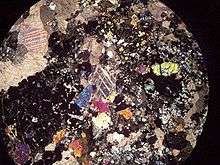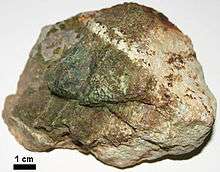Skarn
Skarns or tactites are hard, coarse-grained metamorphic rocks that form by a process called metasomatism. Skarns tend to be rich in calcium-magnesium-iron-manganese-aluminium silicate minerals, which are also referred to as calc-silicate minerals.[1][2][3][4] These minerals form as a result of alteration which occurs when hydrothermal fluids interact with a protolith of either igneous or sedimentary origin. In many cases, skarns are associated with the intrusion of a granitic pluton found in and around faults or shear zones that intrude into a carbonate layer composed of either dolomite or limestone. Skarns can form by regional, or contact metamorphism and therefore form in relatively high temperature environments.[1][2][3][4] The hydrothermal fluids associated with the metasomatic processes can originate from either magmatic, metamorphic, meteoric, marine, or even a mix of these.[3] The resulting skarn may consist of a variety of different minerals which are highly dependent on the original composition of both the hydrothermal fluid and the original composition of the protolith.[3]


If a skarn has a respectable amount of ore mineralization that can be mined for a profit, it can therefore be classified as a skarn deposit.[1][2][3]
Etymology
Skarn is an old Swedish mining term originally used to describe a type of silicate gangue, or waste rock, associated with iron-ore bearing sulfide deposits apparently replacing Palaeoproterozoic age limestones in Sweden's Persberg mining district.[5]
Petrology
Skarns are composed of calcium-iron-magnesium-manganese-aluminum silicate minerals. Skarn deposits are economically valuable as sources of metals such as tin, tungsten, manganese, copper, gold, zinc, lead, nickel, molybdenum and iron.[4]
A skarn is formed by a variety of metasomatic processes during metamorphism between two adjacent lithologic units. Skarn can form in almost any lithology type such as shale, granite and basalt but the majority of skarns are found in lithology containing a limestone or a dolomite. It is common to find skarns near plutons, along faults and major shear zones, in shallow geothermal systems, and on the bottom of the sea floor.[3] The mineralogy of skarn is highly related to the protolith.
Skarn minerals are mainly garnets and pyroxene with a wide variety of calc-silicate and associated minerals. Typical skarn minerals include pyroxene, garnet, idocrase, wollastonite, actinolite, magnetite or hematite, epidote and scapolite. Because skarns are formed from incompatible-element rich, siliceous aqueous fluids a variety of uncommon mineral types are found in the skarn environment, such as: tourmaline, topaz, beryl, corundum, fluorite, apatite, barite, strontianite, tantalite, anglesite, and others.[6]
Classification
Skarns can be subdivided depending on specific criteria:
One way to classify a skarn, is by its protolith. If the protolith is of sedimentary origin, it can be referred to as an exoskarn and if the protolith is igneous, it can be called an endoskarn.[2][3]
Further classification can be made based on the protolith by observing the skarns dominant composition and the resulting alteration assemblage. If the skarn contains minerals such as olivine, serpentine, phlogopite, magnesium clinopyroxene, orthopyroxene, spinel, pargasite, and minerals from the humite group, are characteristic of a dolomitic protolith and can be classed as a magnesian skarn. The other class, called calcic skarns, are the replacement products of a limestone protolith with dominant mineral assemblages containing garnet, clinopyroxene, and wollastonite.[2]
Rocks that contain garnet or pyroxene as major phases, are fine-grained, lack iron, and have skarn-like appearances, are generally given the term skarnoid. Skarnoid therefore is the intermediate stage of a fine-grained hornfels and a coarse-grained skarn.[2][3]
Skarn deposits have typical skarn gangue minerals but also contain ore minerals in abundance which are of economic importance. Skarn deposits are therefore classified by their dominant economic element, such as copper (Cu) skarn deposit, or molybdenum (Mo) skarn deposit to name a few.[1][2][4]
Fe (Cu, Ag, Au) skarn deposits
The tectonic setting for calcic Fe skarns tends to be the oceanic island arcs. The host rocks tend to be gabbros to syenite associated with intruding limestone. The tectonic setting for magnesium Fe skarns tends to be the continental margin. The host rocks tend to be granodiorite to granite associated with intruding dolomite and dolomitic sedimentary rocks. Magnetite is the principal ore in these types of skarn deposits which its grade yields from 40 to 60 %. Chalcopyrite, bornite and pyrite are the minor ores.[7][8]
Cu (Au, Ag, Mo, W) skarn deposits
The tectonic setting for Cu deposits tends to be the Andean-type plutons intruding older continental-margin carbonate layers. The host rocks tend to be quartz diorite and granodiorite. Pyrite, chalcopyrite and magnetite are typically found in higher abundances.[7][8]
Formation
Generally, there are two types of skarns that form, exoskarns and endoskarns.
Exoskarns are more common and form on the outside of an intrusive body that comes into contact with a carbonate unit. They are formed when fluids left over from the crystallisation of the intrusion are ejected from the mass at the waning stages of emplacement. When these fluids come into contact with reactive rocks, usually carbonates such as limestone or dolomite, the fluids react with them, producing alteration (infiltration metasomatism).[3]
Endoskarns form within the intrusive body where fracturing, cooling joints, and stockworks have been produced, which results in a permeable area. The permeable area can incorporate material from the carbonate layer. The magmatic hydrothermal fluids that were transported or created by the intrusion interact with the carbonate material and form the endoskarn. Endoskarns are considered to be rare. Both the composition and the textures of protolith strongly play a role in the formation of the resulting skarn.[3]
Reaction skarn is formed from isochemical metamorphism occurring on thinly interlayered sedimentary lithology units that involves a small scale (perhaps centimetres) metasomatic transfer of components between adjacent units.[3][9]
Skarnoid is a calc-silicate rock that is fine-grained and iron poor. It lies between hornfels and coarse-grained skarn.[10][11] Skarnoid tends to reflect the composition of the protolith.[3]
Most large skarn deposits experience a transition from early metamorphism—which forms hornfels, reaction skarns, and skarnoids—to late metamorphism, which forms relatively coarser grained, ore-bearing skarns. The magma intrusion triggers contact metamorphism in the region where sedimentary rocks are present, and forms hornfels as a result. The recrystallization and phase change of hornfels reflects the composition of the protolith. After the formation of hornfels, a process called metasomatism occurs which involves hydrothermal fluids associated with magmatic, metamorphic, marine, meteoric or even a mix of these. This process is called isochemical metamorphism, and can result in the production of a wide range of calc-silicate minerals that form in impure lithology units and along fluid boundaries where small-scale metasomatism occurs (argillite and limestone, and banded iron formation).[1][2]
The skarn deposits that are considered economically important for containing valuable metals are a result of large-scale metasomatism, where the composition of fluid controls the skarn and its ore mineralogy. They are relatively coarser grained and do not reflect the composition of protolith or surrounding rocks.[2][3]
Uncommon types of skarns are formed in contact with sulfidic or carbonaceous rocks such as black shales, graphite shales, banded iron formations and, occasionally, salt or evaporites. Here, fluids react less via chemical exchange of ions, but because of the redox-oxidation potential of the wall rocks.[3]
An antiskarn is a calc-silicate rock that formed by direct metasomatism of silicate rocks by a carbonatite magma.[12] These rocks are characterised by a high-temperature assemblage of diopsidic clinopyroxene, olivine and wollastonite, and an apparent lack of igneous calcite.
Ore deposits
The major dominant economic metals that make up skarn deposits are copper, tungsten, iron, tin, molybdenum, zinc-lead, and gold.[1][2][3][4] Other minor economic minerals include uranium, silver, boron, fluorine, and rare-earth elements.[3]
Some examples of the major economic skarn deposits are *(Note; some of these are currently being mined or have been mined in the past):
- Iron skarns: Dashkesan Mine, Azerbaijan
- Copper skarns: Bingham Canyon Mine, Utah, U.S.A
- Tungsten skarns: Sangdong mine, South Korea
- Gold-bearing skarns: Hedley Mascot Mine, British Columbia, Canada
- Zinc-lead skarns: Santa Eulalia, Chihuahua, Mexico
- Nickel skarns: Avebury Mine, Zeehan, Tasmania (Australia)
- Molybdenum skarns: Yangchiachangtze mine, China
See also
- Ore genesis – How the various types of mineral deposits form within the Earth's crust.
| Wikimedia Commons has media related to Skarn. |
References
- Einaudi, Marco T.; Burt, Donald M. (1982). "Introduction; terminology, classification, and composition of skarn deposits". Economic Geology. 77 (4): 745–754. doi:10.2113/gsecongeo.77.4.745.
- Ray, G.E., and Webster, I.C.L. (1991): An Overview of Skarn Deposits; in Ore Deposits, Tectonics and Metallogeny in the Canadian Cordillera; McMillan, W.J., compiler, B. C. Ministry of Energy, Mines and Petroleum Resources, Paper 1991-4, pages 213-252.
- Meinert, L.D., 1992. Skarns and Skarn Deposits; Geoscience Canada, Vol. 19, No. 4, p. 145-162.
- Hammarstrom, J.M., Kotlyar, B.B., Theodore, T.G., Elliott, J.E., John, D.A., Doebrich, J.L., Nash, J.T., Carlson, R.R., Lee, G.K., Livo, K.E., Klein, D.P., 1995. Cu, Au, and Zn-Pb Skarn Deposits, Chapter 12; United States Geological Survey: Preliminary Compilation of Descriptive Geoenvironmental Mineral Deposit Models: https://pubs.usgs.gov/of/1995/ofr-95-0831/CHAP12.pdf.
- Burt, D. M., (19770. Mineralogy and Petrology of Skarn Deposits: Societa Italiana di Mineralogia e Petrologia, 33 (2), 859-873.
- "Hydrothermal and Skarn Deposits". www.geol-amu.org. Retrieved 2018-03-29.
- Nadoll, Patrick; Mauk, Jeffrey L.; Leveille, Richard A.; Koenig, Alan E. (2015-04-01). "Geochemistry of magnetite from porphyry Cu and skarn deposits in the southwestern United States". Mineralium Deposita. 50 (4): 493–515. Bibcode:2015MinDe..50..493N. doi:10.1007/s00126-014-0539-y. ISSN 0026-4598.
- Soloviev, Serguei G.; Kryazhev, Sergey (2017). "Geology, mineralization, and fluid inclusion characteristics of the Chorukh-Dairon W–Mo–Cu skarn deposit in the Middle Tien Shan, Northern Tajikistan". Ore Geology Reviews. 80: 79–102. doi:10.1016/j.oregeorev.2016.06.021.
- Zarayskiy, G.P., Zharikov, V.A., Stoyanovskaya, F.M., and Balashov, V.N., 1987, The Experimental Study Of Bimetasomatic Skarn Formation: International Geology Review, v. 29, p. 761-858
- Korzhinskii, D.S., 1948, Petrology of the Tur'insk skarn deposits of copper: Academy nauk SSSR, Institute of Geology Nauk Trudy, vvp. 68, Ser. Rundnykh Mestorozhdenii, No. 10, 147p.
- Zharikov, V. A., 1970: Skarns. - Int. Geol. Rev.12,541-559,619-647,760-775.
- Anenburg, Michael; Mavrogenes, John A. (2018). "Carbonatitic versus hydrothermal origin for fluorapatite REE-Th deposits: Experimental study of REE transport and crustal "antiskarn" metasomatism" (PDF). American Journal of Science. 318 (3): 335–366. Bibcode:2018AmJS..318..335A. doi:10.2475/03.2018.03. hdl:1885/143148.